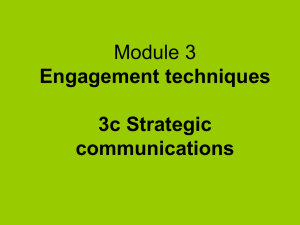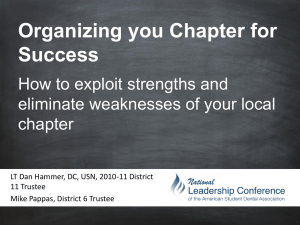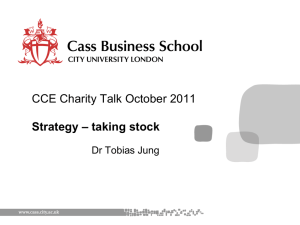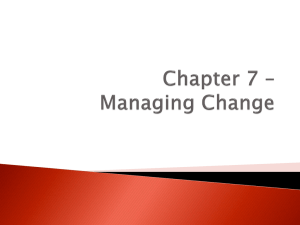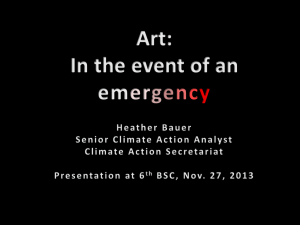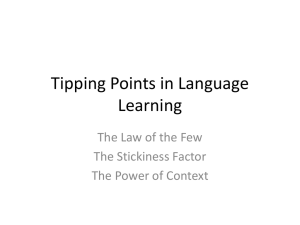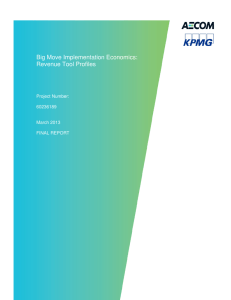1. Ryan Lanyon - Change Agent mini ACT Summit
advertisement
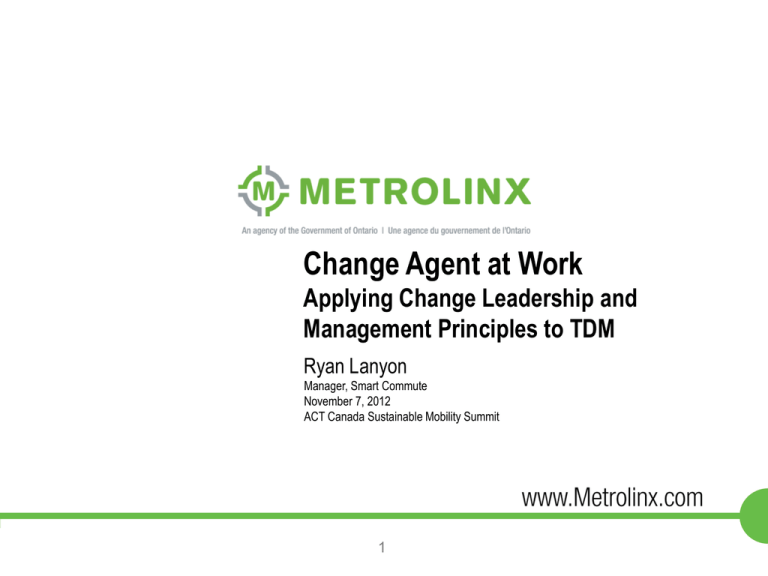
Change Agent at Work Applying Change Leadership and Management Principles to TDM Ryan Lanyon Manager, Smart Commute November 7, 2012 ACT Canada Sustainable Mobility Summit 1 Agenda Assessment Preparation Leading Change: Eight Stages Urgency Coalition Vision Dialogue Empowerment Piloting Tipping Point Culture 2 Assessment: Types of Change Extent of Change Speed of Change Realignment Transformation Incremental Adaptation Evolution Big Bang Reconstruction Revolution Source: Balogun 3 Assessment: Culture Web Source: Balogun 4 Assessment and Preparation: Kaleidoscope Source: Balogun 5 Preparation Change requires: Leadership • Vision • Strategy Management • Plans • Budgets Organizations are made up of individuals 6 Preparation: Individuals Awareness, trial, usage Consumer Behaviour Model • • • • • Transtheoretical Model (TTM) / Stages of Change Theory • • • • • • Identification of a need Information search Evaluation of alternatives Purchase decision Post-purchase behaviour Community-based social marketing • Identify barriers and benefits • Use tools to address these 7 Pre-contemplation Contemplation Preparation Action Maintenance Relapse Preparation: Individuals Source: Balogun 8 Assessment: The Change Formula Is it worth moving forward? Dissatisfaction x Vision x First Actions > Resistance DxVxF>R D/10 x V/10 x F/10 > R/1000 D, V, F = / = 0 9 Leading Change: Eight Stages Adapted from Leading Change by John P. Kotter Urgency Coalition Vision Dialogue Empowerment Piloting Tipping Point Culture 10 Step 1: Urgency Fight complacency! Incent action Gain cooperation around an initiative Raise priority Get buy-in 11 Raising Urgency Crisis Talking Consultants Move, parking supply Examples of excess Spending too much Frivolous mileage External demands Targets Municipal requirements Environmental, transport Stop “happy talk” Accountability Data I’m going to quit for parking Bombard people Did you know…? 12 Step 2: Coalition Importance of Coalitions Need a balance of power, resources and influence • Green teams? Change must be guided by stakeholders affected by it • All business units or operating divisions Cross-section of the department or company to ensure change is managed and led from various viewpoints • CEO’s Office, HR, Real Estate, Health & Safety, Sustainability 13 Building the Coalition Existing or new? Find the right people Power position Expertise Credibility Leadership Create trust Develop a common goal 14 Step 3: Vision Purpose of a Vision Forced planning Agreement Clarity Efficiency Inspiration 15 Creating the Vision Steps Considerations Draft Develop Engage Revise 16 Teamwork Investment Emotion Indirect path Effective Visions Imaginable Desirable Feasible Focused Flexible Communicable Tear down comfort zones Appeal to customers, employees, stakeholders Take advantage of opportunities Exploit no one 17 Testing Your Vision If the vision is made real, how will it affect employees? Will they be more satisfied? In a few years, will we be doing a better job? How will the vision affect stockholders or stakeholders? 18 Vision Statement Examples We are going to sell healthier food to our customers. We are going to reduce red tape and make our customers happier. We are going to move our office to be closer to our employees. Metrolinx: Working together to transform the way the region moves. 19 Step 4: Dialogue Why is it important to engage in dialogue about change? Change makes people uncomfortable Everyone needs to be part of the change The change is not simple; questions arise Everyone needs to know, feel included 20 Effective Communication Simple Through metaphor, analogy or example Multiple channels Repetition Leadership Address inconsistencies Two-way Large meetings/town halls Memos Newsletters/bulletins Posters Word-of-mouth Events Mass mail (voice and electronic) 21 Simple and Effective Communication Before Through a process of debureaucratization, we will empower our frontline employees to better serve idiosyncratic customer requirements. After We are going to throw out some of the rule books and give employees more discretion to do the right thing for our customers. 22 Metaphorically Effective Communication Before We need to retain the advantages of economies of great scale and yet become much less bureaucratic and slow in decision making in order to help ourselves retain and win customers in a very competitive and tough business environment. After We need to become less like an elephant and more like a customer-friendly Tyrannosaurus Rex. 23 Step 5: Empowerment How do you empower employees? See: Stages 1-4 Make them change agents • Provide autonomy, resources and support Ensure their voices are heard • Reinforces the importance of dialogue 24 Step 6: Piloting Pilot projects create short-term wins. Possibility and feasibility Demonstrate cost savings Demonstrate increased revenue Streamline procedures Increased effectiveness 25 Necessity of Piloting Sacrifices are worth it Provide an opportunity to celebrate Fine-tune vision and strategies Undermine cynics and resisters Keep management on board Build momentum Criteria for a short-term win Must be explicit Must be visible throughout the organization Must be clearly related to the change effort 26 Step 7: Tipping Point Change moves from a project to an operation More people will need to get involved • Multiply the change agents Senior management needs to lead Multiple initiatives will run concurrently Timeframe for change will extend Eliminate obsolete interdependencies • Parking minimums! 27 Balance of Leadership and Management 28 Tipping Point Challenges Longer timeframe; task seems more daunting Deeper organizational commitment Personal dynamics Staff turnover / reorientation Exhausted coalition member Complacent manager Complimentary saboteur 29 Step 8: Culture What is culture? Norms of behaviour Shared values • Metrolinx: Commitment, Service, Working Together, Innovation Culture impacts Corporate culture affects everyone • Subcultures are specific to subunits Difficult to change - Invisible and hard to address Linked to human emotion 30 Power of Culture Can influence behaviour Is pervasive Exists through thousands of small interactions Reinforces itself Must ‘fit’ the organization Stories and legends set and maintain the tone Happens without conscious actions or thoughts 31 Role of Culture Anchoring change Comes last, not first Depends on visible results Requires much discussion May involve changing key people Makes decision on succession crucial Takes time, patience and persistence 32 Mapping a New Culture Web Source: Balogun 33 Mapping a New Culture Web Symbols Free parking. Stylish bicycle racks at the door. Controls Do we pay people to drive to meetings, but expect them to cover the cost of taking transit? Cycling? A policy that provides a decision-making process favouring sustainable (and most affordable) modes Stories Was: “I got a huge mileage check and bought a new TV.” Now: “I started carpooling and saved enough for a new TV.” 34 Thank You! Contact Sources Balogun, J. “Strategic Change” in Management Quarterly. UK: Cranfield University (2001). Ryan Lanyon Manager, Smart Commute Metrolinx 416-874-5933 ryan.lanyon@metrolinx.com www.smartcommute.ca http://www.tomorrowsleaders.com/A5569D/icaew/conte nt.nsf/DocumentLookup/ICAEWSTR0109/$file/MQ10+S trategy.pdf Brown, P. A Brief Introduction to Change Management. YouTube (2011). http://www.youtube.com/watch?v=3Jk6clmMycI&hd=1 Kotter, J. Leading Change. USA: Harvard Business Review Press (1996). Mckenzie Mohr, D. and Smith, W. Fostering Sustainable Behaviour. Canada: New Society Publishers (1999). 35
